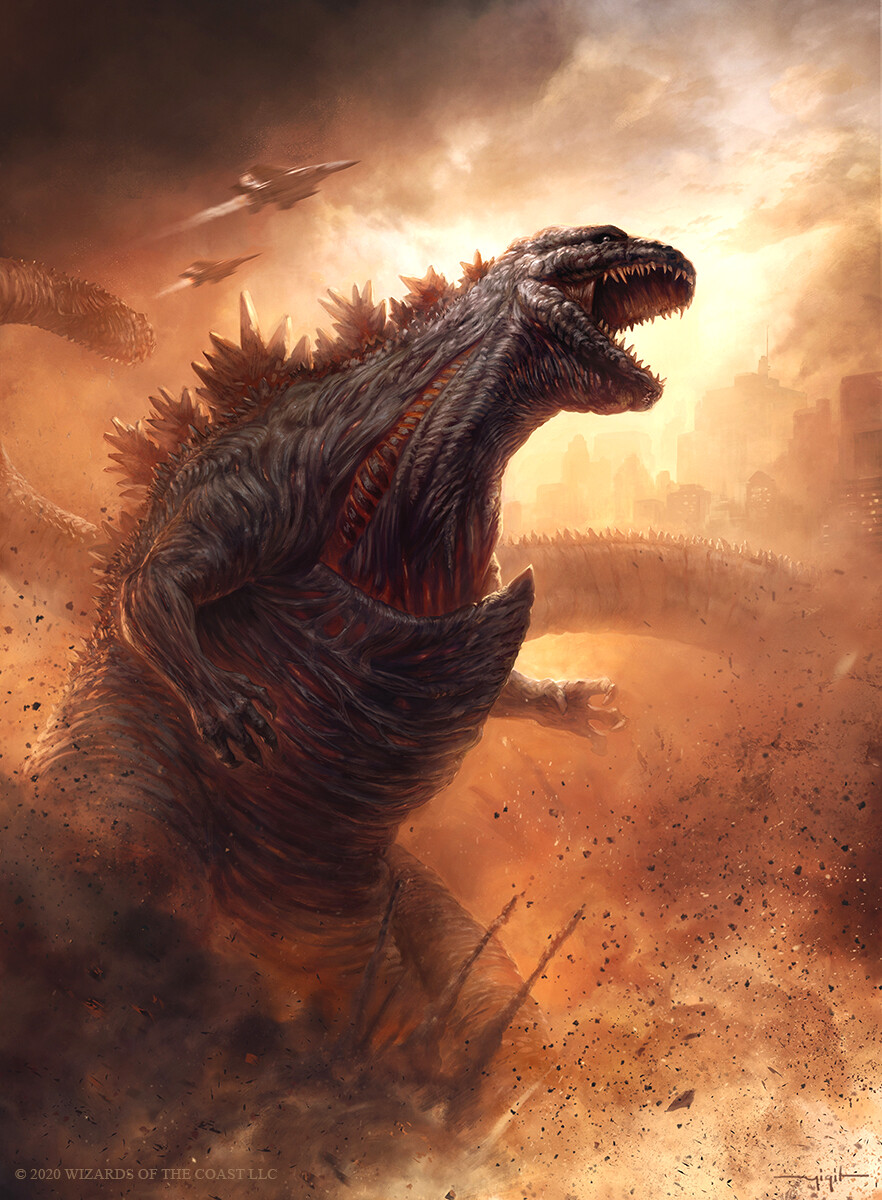Ikoria: Lair of Behemoths is set on the treacherous world of Ikoria, where gargantuan beasts fight for survival while humans hide at the bottom of the food chain. Mutate and companion have arrived, cycling is back, and Godzilla (!) has joined in on the fun. We’ve never seen a set like this before and who knows if we ever will again — which is all the more reason to bring a few members of the SCG staff together to give their first impressions on Magic’s newest set in the best way possible: before playing a single game with any of the cards.
1. What is your Tweet-length review of Ikoria: Lair of Behemoths?
Nick Miller: Ikoria truly looks like the first set made with digital play at the forefront of the designers’ minds. Every mechanic other than cycling is going to work more easily on Arena than in paper, and even some of the cycling cards have tracking requirements. I’m equally excited and scared.
Emma Handy: Ikoria: Changing how the game is played via cards so complicated they literally had to change how layers work.
Ryan Overturf: Remember that Commander precon with all the Dragon Cats or whatever? Ikoria is like that, but Standard-legal. There’s even Commanders and everything! Also Godzilla.
Dom Harvey: Wizards of the Coast (WotC) had to issue a “Statement on Spacegodzilla” and that might not be the strangest thing about this set. If that isn’t a statement, I don’t know what is.
Ari Lax: We were promised a set with all the elements of video game monster franchises baked into one, and it turns out choosing your starting Pokemon will be the most important and popular part. Honestly, I’m not sure what I expected.
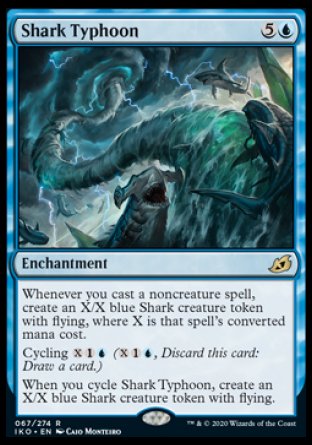
2. What is your most-liked card in Ikoria: Lair of Behemoths?
Dom Harvey: Shark Typhoon. Magic once had a rich lore that prided itself on its worldbuilding. Recently, the game has leant heavily on top-down adaptations of familiar stories and revisiting its own creations by beating a dead Akroan Horse until we’re begging for something new. Why not take the mask off and fully embrace the most priceless gem in the Western canon, Sharknado?! I just hope that we get equally inspiring designs for Return to Sharknado, Battle for Sharknado, Sharknados over Innistrad, and Sharknado Beyond Death…
Pedigree aside, this is a genuinely great design. This is excellent both with and against control – notably allowing counterplay against Teferi, Time Raveler – and a good fit in the various ramp strategies dominating Standard without being too obnoxious. The scaling on the cycling ability prompts interesting choices over when and how to cash it in. Decree of Justice may be showing its age but this is a nice homage to it!
Ari Lax: Snapdax, Apex of the Hunt. Snapdax is by far my favorite card in the set. It makes you want to do all the Ikoria things, but gives you a lot of flex to build around and isn’t egregious like Uro or Oko. Your deck wants a third color, but only a bit, and it wants non-Humans, but you can choose specific ones from any set, and Snapdax triggers might even convince me to play other mutate creatures.
Honorable mention to Memory Leak for giving me more great excuses to play discard spells in Draft.
Ryan Overturf: I’ve been fooled by cards like this plenty of times, but I’m exactly stupid enough to love Sprite Dragon. There’s plenty of room to be better than Stormchaser Mage without being good, but I’m willing to have the football pulled away from me at least one more time.
Nick Miller: Yidaro, Wandering Monster. The first playable Turtle and what a Turtle it is. I love everything about this card: the comical use of haste, the art, the wacky tracking requirement, and even the fact that it can be cycled onto the battlefield uncounterably to kill Teferi, Time Raveler. This is the type of creative design I like to see.
Emma Handy: Fire Prophecy. Fire Prophecy simply does a ton of things that I like doing in Magic: efficiently killing creatures and playing card selection. Fire Prophecy feels like it’s getting to do something for free in its selection and that’s incredibly valuable. The potential for it to be abused in combo shells is even more exciting.
In a world where WotC is leaning into flashy, powerful, engine effects, I can’t help but fall in love with the role-players.
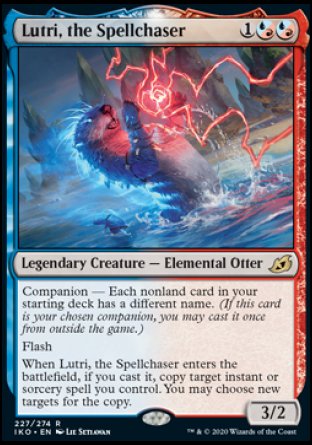
3. What is your most-hated card in Ikoria: Lair of Behemoths?
Ari Lax: Jegantha, the Wellspring. It’s everything miserable about the companion mechanic rolled into one card. The restriction is extremely marginal, and the upside beyond being free real estate of a body is negligible. You just kinda shove it in your deck if you meet the criteria, and all it does is give you a free card every game. That’s not remotely interesting, just ubiquitous, warping, and invasive to the entire prior design of Magic.
Emma Handy: Lutri, the Spellchaser. I’m sympathetic to the fact that WotC was likely unsure of whether or not the companion mechanic would end up working in Commander and didn’t balance Lutri with Commander in mind. That being said, I believe it to be the most difficult companion restriction to track, as well as the easiest to exploit. It may just be that I’m paranoid, but there’s a lot going on with this card that I do not care for.
Ryan Overturf: Ketria Triome. As somebody who has happily played Frontier Bivouac in Pioneer, I think it’s safe to say that wedge players are spoiled rotten. Opulent Palace is played in one of the best Pioneer decks! Meanwhile, despite the joy I would receive from a simple Crumbling Necropolis reprint I got snubbed again. At least finish the cycle, cowards!
Nick Miller: Lurrus of the Dream-Den. I could pick any of the clearly busted companion creatures here, but I think Lurrus will be the most problematic one. Enough has been written already by people like Sam Black and Ari Lax to break down how troublesome these cards could turn out to be, but there’s more. Many similar games have tried these deckbuilding restriction cards to incredibly poor results. Hearthstone literally had to speed up its rotation a year after its failed experiment with odd/even cards, and Eternal has an only-even-card creature that has resulted in multiple cards being nerfed around it. I don’t think Magic R&D should be the latest designers to think they can solve this type of mechanic, or to quote No Country For Old Men: “You can’t stop what’s coming. It ain’t all waiting on you. That’s vanity.”
Dom Harvey: Titans’ Nest. Someone decided that delve was fun and harmless enough to return but without any of its intuitive simplicity. Perhaps a design like this needs to have some safeguards – better a Whirlwind of Thought than a Song of Creation, right?! – but those neuter what made the card interesting and lead to further questions. Why can’t I cast an Eldrazi Skyspawner with this (if the answer is that we’re pretending devoid never happened, that’s fair)? What’s the X-spell you’re terrified will break this card? Hydroid Krasis was never the problem…
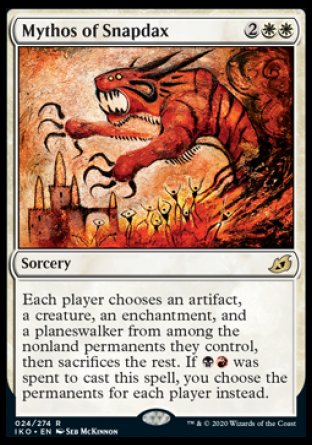
4. Rank the Mythos cycle from worst to first.
3. Mythos of Illuna
This list is based on a carefully crafted system adjusting for the relative floor, ceiling, and castability of these cards. I will not be discussing my system at this time.
5. Mythos of Brokkos – Look, Diabolic Tutor hasn’t been a heavy hitter in any format and that isn’t going to change. Same thing goes for Regrowth. Combining the two doesn’t excite me much and let’s not forget there really isn’t a strong Sultai deck in Standard.
4. Mythos of Nethroi – Three mana to kill a creature doesn’t look very good in a set introducing Heartless Act. Three mana to kill a nonland permanent also doesn’t shine when Assassin’s Trophy already exists. Finally, the wording on this card is enough to justify its low ranking.
3. Mythos of Illuna – Copying creatures is nice, but copying any permanent can be abused much, much harder. Notably, this isn’t limited to your permanents, so feel free to catch up in any Fires or Ramp matchup. If we happen to get a playable Temur deck, unlike last time we had a wedge set, this will be fantastic.
2. Mythos of Snapdax – It’s no surprise the top three choices fill out Jeskai colors and can all slot into Jeskai Fires. This will let you catch up or even the score against a lot of the top decks as they all have enchantments, artifacts, or planeswalkers with their creatures and that isn’t even taking into consideration a Mardu deck casting this.
1. Mythos of Vadrok – I think this is the sleeper pick of the cycle. Splitting five damage for four mana is solid at its floor and the things this card can do when played in Jeskai are terrifying. Using this to set up a kill on the next turn or having it do exactly enough to buy another turn will prove its versatility and level of power.
Emma Handy:
5. Mythos of Illuna
Y’all remember how strong Tragic Arrogance was? That card absolutely dominated its Standard format on the back of how hard it could break open a stalled battlefield in the favor of its caster. With all of the engine cards that are seeing print these days, it’s hard to imagine Snapdax not being better than its sister-spell was back in the day, which is saying a lot.
Mythos of Illuna, on the other end of the spectrum, is just kind of a copy of Clever Impersonator with upside. The differences between the best and worst Mythos is stark and it’s gonna take a very specific format for Snapdax, Nethroi, and Vadrok not to see play.
5. Mythos of Illuna is a hard-to-cast Clone in a colour combination that’s aiming so much higher.
4. Mythos of Snapdax suffers the terrible fate of being a Mardu card. When was the last time Mardu was good in Standard?! A cheaper Tragic Arrogance isn’t what the long-suffering Mardu Guy is looking for.
3. Mythos of Vadrok looks better than it is – we’ve already been burned by Aurelia’s Fury (okay, nobody has ever taken damage from Aurelia’s Fury despite its $50 price tag on release but you see the point). This is the best Mythos as a monocolored card.
2. Mythos of Brokkos has the worst rhymes but the most potential. We’ve already seen Sultai Midrange shells make good use of permanent pairs – Hydroid Krasis with Nissa, Who Shakes the World (the real problem!) or Uro, Titan of Nature’s Wrath with Cavalier of Thorns – and there are some excellent targets in this set.
1. Mythos of Nethroi is an easy champion. Instant-speed Vindicate is even better than it looks in a format full of game-winning enchantments and planeswalkers that demand immediate answers.
5. Mythos of Vadrok – You aren’t tricking me with Aurelia’s Fury in 2020.
4. Mythos of Illuna – You can’t Clone Uro, Titan of Nature’s Wrath or Hydroid Krasis.
3. Mythos of Nethroi – Murderous Rider is a hard act to follow.
2. Mythos of Snapdax – We’re in more of a Casualties of War era now, but Tragic Arrogance was great in 2015.
1. Mythos of Brokkos – By the time this publishes, Ali Aintrazi will have four different decks trying to play this and at least one might be good.
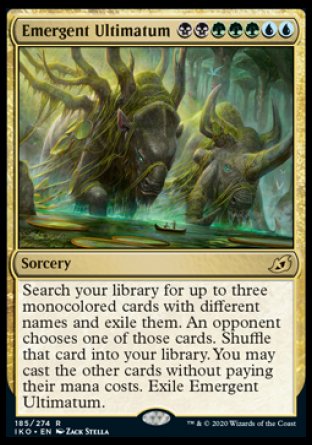
5. Rank the Ultimatum cycle from worst to first.
Emma Handy:
5. Genesis Ultimatum
1. Inspired Ultimatum
Okay, first things first: I’m ranking these cards based on their Standard playability. In other formats, it’s going to vary wildly (Ruinous and Eerie Ultimatum, for example, are going to tear up Commander). Emergent Ultimatum is painfully easy to break in half (Omniscience, Tooth and Nail, Griselbrand being the first combo that comes to mind) the more the card pool in a format expands. Inspired Ultimatum’s power is going to be much stronger in formats that involve long, grindy games, rather than mana-efficient condensed games.
The lone wolf here is Genesis Ultimatum. Sure, the card is a just-better version of Brilliant Ultimatum, but being a better version of a card that was more or less unplayable isn’t a tough bar to clear. Genesis Ultimatum having the ability to just hit a pile of lands or just more copies of cards that aren’t putting the game away makes it difficult to justify registering, and I’d be shocked if it got much play in any format that isn’t casual.
5. Genesis Ultimatum – LOL. Name a more iconic duo than Temur and its wedge cards woefully underperforming.
4. Eerie Ultimatum – This requires a lot of work and a lot of mana to pay off and I just don’t see it. Standard is so powerful right now that reanimating a handful of permanents doesn’t really move the needle any considerable amount.
3. Inspired Ultimatum – Despite its design being quite uninspired, this is a swingy card. My only concern is once again with the power level of the format and whether or not this does enough in a world of Fires of Invention; Uro, Titan of Nature’s Wrath; and Witch’s Oven decks.
2. Ruinous Ultimatum – The cleanest of the cycle, this card is what it is. If there’s a playable Mardu deck, this card will be a part of it. A one-sided Planar Cleansing can only be so bad.
1. Emergent Ultimatum – I’m not smart enough to solve this problem, but someone will find the three cards that lead to a kill once this resolves. Even if it isn’t an auto-win card, free spells are always worrisome.
Dom Harvey: Clarion Ultimatum is not from this set’s cycle but deserves a mention as a cautionary tale. It’s quite difficult to design a splashy flagship mythic that’s automatically unplayable in Constructed, Limited, and the most popular casual format all at the same time, but this card is a clarion call for game designers everywhere to do better. Even the loser on this list can take solace in the fact that it could never be the true worst Ultimatum. With that in mind…
5. Ruinous Ultimatum: When Mardu has almost been good in Standard it’s been because the tools are there for an aggressive deck. Tournament Grounds hasn’t cast anything in a while but it sure doesn’t cast this! It wouldn’t want to even if it could!
4. Emergent Ultimatum: In a set with a multicolored theme following up yet another trip to Ravnica, the cards you most want to find with this are all off the table. Combustible Gearhulk can tell you that giving opponents choices is an easy way to find yourself the worst of your cycle…
3. Genesis Ultimatum: A decade ago, people had a lot of fun trying to Brilliant Ultimatum into Emrakul, the Aeons Torn. This Ultimatum may be even more brilliant but the Emrakul equivalent simply isn’t there yet and the permanent restriction prevents you from chaining these together.
2. Inspired Ultimatum: The rate on this was fine for the original Ultimatums but the rate on the best threats in today’s Standard is so much better. Uro, Nissa, Dream Trawler, and many more laugh this off – if they haven’t finished you off by then.
1. Eerie Ultimatum: The card Mark Rosewater tells Primevals’ Glorious Rebirth not to worry about. I don’t have high hopes on this one either but this may take over Command the Dreadhorde’s role as the best way to go over the top of a format full of heavy hitters.
4. Genesis Ultimatum
2. Inspired Ultimatum
I might have Emergent and Inspired backwards based on how good a deck that actually played these cards would be, but my ranking is based on which of these cards is most likely to win immediately when the spell resolves. Mardu once again gets completely shafted and wedge players demonstrate how spoiled they are by underappreciating how obscene the value of Inspired Ultimatum is. Everybody complaining about gaining five life could use one.
5. Ruinous Ultimatum – Mardu is scientifically the worst color trio outside of aggro.
4. Emergent Ultimatum – Maybe wins the game if you play six other pieces of cardboard garbage. Maybe.
3. Eerie Ultimatum – Seems like it wins the game with normal cards, but Nethroi, Apex of Death seems like it does the same but easier.
2. Genesis Ultimatum – Most obviously good one due to Growth Spiral, Unpredictable Cyclone, and Boon of the Wish-Giver.
1. Inspired Ultimatum – Slightly worse than Cruel Ultimatum, so your opponent has more reason to keep trying to play and lose anyway. Savoring their misery was always the best part of that card.
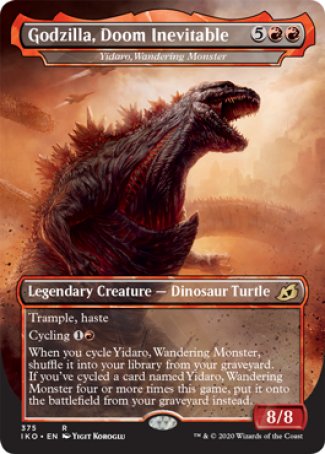
6. Which of the nineteen Godzilla Monster Series cards would win in a battle royale?
Ari Lax: Gidorah, King of the Cosmos. Having watched a solid number of classic Godzilla movies as a kid, the lore answer is probably MechaGodzilla. Actual Godzilla is kind of a chump who gets beat up a bunch and often needs help to win, and MechaGodzilla is absolutely brutal when it shows up.
But considering the cards too, a Centaur Courser artifact is not going to win. I’m also not even sure what the English translation of that alternate name is since it is only available in Japan. King Gidorah is also really strong in Godzilla lore, and it’s hard to argue any of the Apex cycle doesn’t stack up in card power level here.
Emma Handy: Is there an answer to this that isn’t just Godzilla, King of the Monsters? There was literally a documentary about this that came out last year. Come on people!
Nick Miller: Dirge Bat. Why? Two words: eye lasers – scratch that. Three words: Flying eye lasers. Have fun getting melted on the ground, idiots.
Dom Harvey: Babygodzilla, Ruin Reborn. Could you bring yourself to harm that thing? Just look at it! Aww…
Ryan Overturf: Godzilla, Primeval Champion. Biggest stats. Champion right in the name. This one is really too easy. Pretty sure he wins everything in the source material, too? I don’t know, I’m not a Vorthos.
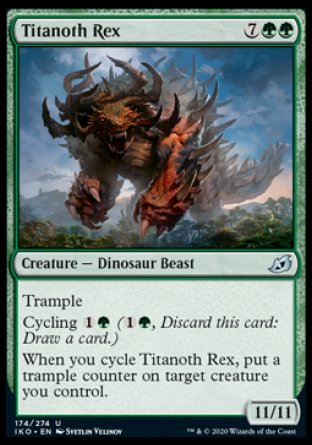
7. Would you rather fight 100 duck-sized Titanroth Rexes or one Titanroth Rex-sized duck?
Ryan Overturf: One Titanoth Rex-sized duck. Even if they’re small, that thing looks spiky and resilient. At least one person in the Jurassic Park series gets devoured by tiny carnivorous Dinosaurs, and duck-sized carnivorous spike monsters are still carnivorous spike monsters. I probably wouldn’t register to a giant duck and while I might struggle to defeat it, perhaps it could be reasoned with.
Ari Lax: 100 duck-sized Titanroth Rexes. The odds aren’t great, but anyone selecting one giant duck is a maniac. I present the classic animation “Bambi Meets Godzilla” as evidence.
Nick Miller: I don’t think 100 Nick Miller could take down anything the size of Titanoth Rex, so I will take my chances with the herd of duck-sized Dinos. I’ll be the one with the trample token in this fight and can use the terrain to my advantage to funnel them into a stomping pit.
Emma Handy: Honestly, I haven’t been in a fight in so long that I’m just gonna choose the option that would make losing the least painful: one Titanroth Rex-sized duck. All I can hope for is that it squishes me instantly, rather than forcing me to suffer.
Dom Harvey: As someone who has organized tournament trips with just a half-dozen Magic players, I’m skeptical of the duck-sized Dinosaurs’ ability to agree on anything, let alone present a united front in mortal combat.

